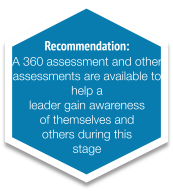4 Leadership Transitions and the Support Your Leaders Need
Leadership transitions can be described as any significant change in a Leader’s role: mergers, promotions, acquisitions, hybrid and remote work – these are just a handful of examples.
There are four transitional “levels” during a typical leadership journey.
From leading the self all the way through and up the leadership channel to top C-Suite executives leading at the organizational level, read more to learn about what each transition looks like and the type of support your Leaders likely need at each.
Leading Self

This is where the individual begins their professional journey. At this level, the leader begins to:
- Build self-awareness through self-assessments and by asking for and getting feedback
- Reflect on what they want, how they want to show up, and what they want to be known for in the organization
- Work on their emotions, learning to become emotionally agile, developing EQ (emotional intelligence)
- Learn to manage their energy and stress levels
- Gain the understanding that they have ownership of their career development
- Learn to engage in tough conversations – sometimes with their manager
Leading Others
During this stage, it’s important to continue gaining perspective on the self, but also considering the perspectives of others (we often see ourselves one way, others perceive us in another way – it may be that neither is exactly true, but it’s important to be aware of these differences and begin to identify areas we want to change.

At this level, leaders will begin to:
- Recognize efforts of others and learn the importance of showing appreciation for others
- Build communication skills, particularly in motivating others
- Work with people who differ from us in terms of style, POV’s, gender, even looks
- Discover how to resolve conflict between others, particularly in a way that everyone wins
- Develop effective delegation, and recognize that delegating isn’t just dumping work over the wall. It’s understanding where the other team members want to go and being selective in what you delegate, linking back to where they want to grow in their career development
- Understand how to lead teams in alignment with the foundations of leadership within this company
- Learn to be a coach as a manager
- If there are any type of diversity and inclusion initiatives, this would be when you’d introduce diversity training, diversity and inclusion programs
Leading Other Managers

This is when a Leader begins making strategic decisions that go across the team and then driven down through the managers.
At this level, a Leader will begin to:
- Set the goals and expectations that are linked to the overall company strategy
- Hold managers accountable for doing the right work as a manager (it’s not always about them doing the tactical duties of a manager, but also leveraging their teams and developing their people)
- Create the cadence for the key stakeholder communication (How many times will we meet? How long will we meet? What’s the purpose of that meeting?) and then sticking with that
Leading at the Organization Level
 The biggest responsibility at this stage is in creating the culture of the organization. Those at this level house the underpinnings and articulation of the culture and how the organization wants to be seen from the outside world. The expectation here is about thinking and acting strategically.
The biggest responsibility at this stage is in creating the culture of the organization. Those at this level house the underpinnings and articulation of the culture and how the organization wants to be seen from the outside world. The expectation here is about thinking and acting strategically.
At this level, a Leader will begin to:
- Create the insights that will align with the vision and goals of the organization
- Learn to collaborate cross-functionally (i.e., C-suite being able to work well as a team among themselves, while recognizing that they may each have different priorities, yet they have to find a way to work together in a manner that benefits the organization in a broad sense.)
- Continue to build relationships and networks internally as well as externally
- Lead initiatives from an action-learning perspective, and learn to ask the right questions to reach the best solution
Interested in learning more? Contact us at: sales@coachingrightnow.com – we look forward to helping!





